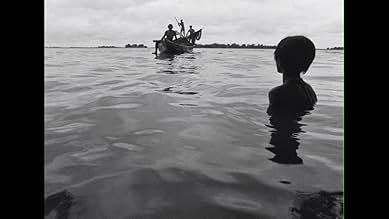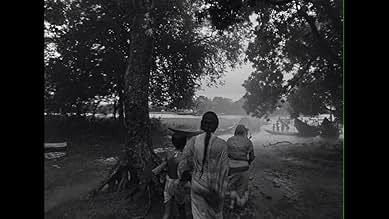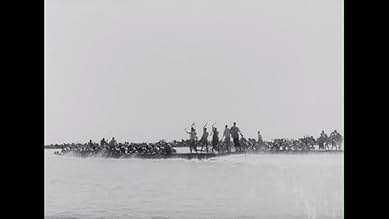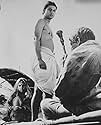NOTE IMDb
7,2/10
1,4 k
MA NOTE
Un des pêcheurs habitant sur la rive du fleuve Titas épouse une fille d'un autre village, qu'il a sauvée du sacrifice après la mort de son mari, mais elle se fait aussitôt enlever par des pi... Tout lireUn des pêcheurs habitant sur la rive du fleuve Titas épouse une fille d'un autre village, qu'il a sauvée du sacrifice après la mort de son mari, mais elle se fait aussitôt enlever par des pirates.Un des pêcheurs habitant sur la rive du fleuve Titas épouse une fille d'un autre village, qu'il a sauvée du sacrifice après la mort de son mari, mais elle se fait aussitôt enlever par des pirates.
- Réalisation
- Scénario
- Casting principal
Avis à la une
Typically for Indian movies this has it all, evil capitalists that destroy the property of the poor peasants, a man struck insane by the abduction of his newly-wed wife from arranged marriage, compassionate families that end up turning against the one they help and a lot of smoking from water pipes and chewing of betel nut.
The film starts by announcing that not many people know about and much less care about the people living in this region which is one of the world's poorest places. And by the end of it most things look very unfortunate for them still. It is realistically made, shot on location so that doesn't feel contrived. That being said, some of the acting looks funny and artificial by our standards. As we move focal points also it can be a little difficult to follow the numerous plots.
Antropologically interesting too.
The film starts by announcing that not many people know about and much less care about the people living in this region which is one of the world's poorest places. And by the end of it most things look very unfortunate for them still. It is realistically made, shot on location so that doesn't feel contrived. That being said, some of the acting looks funny and artificial by our standards. As we move focal points also it can be a little difficult to follow the numerous plots.
Antropologically interesting too.
I am just trying to justify my rating of the film (9 out of 10) which demands a perusal of its technical excellence.
This film is an adaptation of Adwita Malla Burman's Bengali literary classic under the same title. It is tale of those marginal people belonging to a poorer fishing community who live from hand to mouth. Exploring different sectors of life is one of the most amazing aspects of both the film and the novel.
The film sequences are maintained in parallel to the novel. The film has brilliant editing and that makes it very dynamic and fluent. Fade-ins and fade-outs for transition are used in many cases. The film seems to be gradually acquiring technical sophistry. Fixed frame is used in many cases and the camera movement is kept at a minimal level at the beginning of the film. Panning, tilt-ups and tilt-downs are countable. But this 'apparently' mediocre camera usage could not amputate Ghatak's craftsmanship. Some continuity cuts during the long duration shot of 'Dourer Naw' (Boat for Running Races) certainly deserve positive appraisal. The film has some stunning close ups. They really deserve applause. The close ups are symbolic and very well-articulated.
Negative aspects are minimum but they cannot be overlooked as they have an effect on the film. Sometimes the characters deliver speeches in a word or two in urban Bengali which betray the realism their acting. The film has got only two framing errors. It is the disadvantage of using fixed frame. Moreover the spectators are captured who came to watch the shooting for once (while Basanti was engaged in a fight with her mother) in the film. In another case, probably the prompter is captured or the person may be another spectator while Kader Mian was arguing with his daughter-in-law. The sequences sometimes seem to be incredulously positioned. Moreover, they seem to be hastily pushed towards their respective ends. But Ritwik's crave for stark realism is praiseworthy. Other than these, this film is technically perfect.
The film is a must watch for having a better exposure of the lives of marginal people of a third world country. Technical excellence is another reason to watch this film.
This film is an adaptation of Adwita Malla Burman's Bengali literary classic under the same title. It is tale of those marginal people belonging to a poorer fishing community who live from hand to mouth. Exploring different sectors of life is one of the most amazing aspects of both the film and the novel.
The film sequences are maintained in parallel to the novel. The film has brilliant editing and that makes it very dynamic and fluent. Fade-ins and fade-outs for transition are used in many cases. The film seems to be gradually acquiring technical sophistry. Fixed frame is used in many cases and the camera movement is kept at a minimal level at the beginning of the film. Panning, tilt-ups and tilt-downs are countable. But this 'apparently' mediocre camera usage could not amputate Ghatak's craftsmanship. Some continuity cuts during the long duration shot of 'Dourer Naw' (Boat for Running Races) certainly deserve positive appraisal. The film has some stunning close ups. They really deserve applause. The close ups are symbolic and very well-articulated.
Negative aspects are minimum but they cannot be overlooked as they have an effect on the film. Sometimes the characters deliver speeches in a word or two in urban Bengali which betray the realism their acting. The film has got only two framing errors. It is the disadvantage of using fixed frame. Moreover the spectators are captured who came to watch the shooting for once (while Basanti was engaged in a fight with her mother) in the film. In another case, probably the prompter is captured or the person may be another spectator while Kader Mian was arguing with his daughter-in-law. The sequences sometimes seem to be incredulously positioned. Moreover, they seem to be hastily pushed towards their respective ends. But Ritwik's crave for stark realism is praiseworthy. Other than these, this film is technically perfect.
The film is a must watch for having a better exposure of the lives of marginal people of a third world country. Technical excellence is another reason to watch this film.
This film by somewhat neglected Indian director Ritwik Ghatak is one of the most unusual I have ever seen. The stories are set among the harsh life around the banks of Bangladesh's rivers (one of the poorest regions of the world). It tells several gruesome tales: abductions, escapes, living among strangers, death, though the characters go through this with the resignation of someone who knows that life is hard and always have been. Now, having seen this film more than a decade ago, I cannot recall all the details. But the unusual part is the way this story is told. It puts a character at the center of the story for, say, twenty minutes, and then it moves to another character, who was playing a minor role in the first story. And then to another character, and so on. It is a collection of stories, but loosely (or not so loosely interconnected). Overall, a fine tapestry of life in one of the poorest parts of the world.
1. River and River and life related to that clearly depicted in the film Titas( Name of a river and peoples around it ) Ekti Nodir Naam ( Name ).
2. Clearly depicts how peoples of different religion lives side by side without effecting their livelihood. and still role is being played by the peoples who are rich and who are poor . In the name of religion , they created sect , actually which represents the privileged peoples and peoples who lives on fishing, farming and united . But some how money divides them actually rich uses it as a tool to destroy the unity and peace of a community.
3. River scenes, Boats and Rain greatly depicted in the film, excellent cinematography
2. Clearly depicts how peoples of different religion lives side by side without effecting their livelihood. and still role is being played by the peoples who are rich and who are poor . In the name of religion , they created sect , actually which represents the privileged peoples and peoples who lives on fishing, farming and united . But some how money divides them actually rich uses it as a tool to destroy the unity and peace of a community.
3. River scenes, Boats and Rain greatly depicted in the film, excellent cinematography
10smkbsws
When anybody (even I used to say the same) tells you more money leads to lesser art, this epic saga can be a staple example to prove them wrong. This is based on a semi autobiographical novella by Adwaita Mallabarman, depicting the life and times of a fishing society by the bank of a River, called Titas, over a period of time. I can say that this has more distinguishable cast than "Sholay". Or till some extend, this has the range, both chronological and geographical, this even tops "Gangs Of Wasseypur" or "The Godfather" series. There are many features and documentaries on this film and I remember someone telling this was Ghatak's El Dorado (Note that the kid in "Bari Theke Paliye" started his journey by inspired of the stories of El Dorado). One of the major positive change was in editing, and the uber famous Bashir Hossain did show his fresh take on cutting and transitions to both Bangladeshi and West Bengal audience. His technique was so liked that Ghatak hired him again for his own semi autobiographical "Jukti Takko Aar Gappo". Another thing is heavily layered and beautifully set up blocking, which we have been seeing from "Ajantrik" till his latest series, and kudos to Baby Islam's camerawork to take it to the next level. One of my friend told that Ghatak loved the relationship between a boat and camera, which was incepted in "Bari Theke Paliye", shown accordingly in the trilogy and blooms to its full potential in this film. Also, have to mention the plot explicitly as it shows the microcosm of a society of people who belong to the lower caste of a minority section and all the hierarchy was used for plots.
Le saviez-vous
- AnecdotesDirector Ghatak appears in the film as a boatman, and Basanti's story is the first of several melodramatic tales.
Meilleurs choix
Connectez-vous pour évaluer et suivre la liste de favoris afin de recevoir des recommandations personnalisées
Détails
- Date de sortie
- Pays d’origine
- Site officiel
- Langue
- Aussi connu sous le nom de
- A River Called Titas
- Société de production
- Voir plus de crédits d'entreprise sur IMDbPro
- Durée2 heures 39 minutes
- Couleur
- Mixage
- Rapport de forme
- 1.37 : 1
Contribuer à cette page
Suggérer une modification ou ajouter du contenu manquant

Lacune principale
What is the Mexican Spanish language plot outline for Une rivière nommée Titash (1973)?
Répondre

























